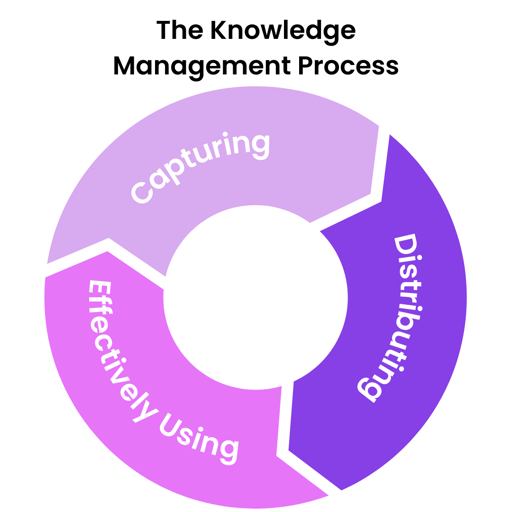The Ultimate Guide to Knowledge Management for 2022

Octopus vs. Human: the power of our collective knowledge
Octopuses are incredibly intelligent creatures. With nine brains and a distributed nervous system, they are able to learn, solve puzzles, use tools, and even play the occasional prank on unwitting aquarium staff (The Guardian, 28 March 2017). But with short lifespans and largely solitary behavior, they don’t seem to be able to learn from each other. Though an individual octopus might learn how to open a jar, it’s unlikely to be able to share that learning with others.
Humans, on the other hand, are quite different. Our ability to document and share knowledge with each other has allowed us to develop an ever-improving collective intelligence. We can build on each other’s ideas, learn from each other’s mistakes, and achieve astonishing innovations as a group. But within these processes, there is a lot of room for things to go wrong. Minds forget, findings are lost, or people neglect to share their findings with others. Think about the sheer number of fantastic ideas there must be that have never been fully developed because they weren’t shared with the right people at the right time.
Our abilities to learn and innovate are largely dependent on how we manage the knowledge available to ourselves and others. This is true on a broader, societal level, but also within specific organizations.
That’s why we’ve put together this in-depth guide on knowledge management. In the coming sections, we’ll cover the most important things for you and your company to know about knowledge management in 2022.
1. What is knowledge management?
1.1 Stages of the knowledge management process
1.2 The types of knowledge management
1.3 Who is knowledge management for?
2. The benefits of knowledge management
3. Why is knowledge management important?
4. Knowledge management systems
4.1 What is a knowledge management system?
4.2 The types of knowledge management systems
4.3 Not all knowledge management systems are the same
4.4 Who is responsible for maintaining a knowledge management system?
5. What are the first steps to implementing a knowledge management system?
6. What are some signs that your knowledge management strategy is ready for an overhaul?
1. What is knowledge management?
Knowledge management can be summarized as the process of creating, sharing, using and managing the knowledge and information of an organization. Another more succinct way to define knowledge management, introduced by world-renowned IT expert Tom Davenport, is the process of capturing, distributing, and effectively using knowledge.
Both definitions provide a clear overview of the activities involved in knowledge management, and either can serve as a solid starting point for understanding the role knowledge management plays in your organization. Depending on how your organization works with knowledge and insights, you might feel that one of the definitions above suits you better than the other. Or that you’d rather build on them to better reflect your organization’s current approach.
But regardless of exactly how you choose to define knowledge management, it’s important to make it a priority. This is because knowledge management is an essential element of modern business strategies, as it helps to bolster organizational learning, improve organizational practices, and save time and effort for the people it involves, all while leading to better business outcomes. For example, more effective products and campaigns, lower customer acquisition costs, and increased employee productivity.
In short, knowledge management helps groups and organizations achieve their objectives by making the best use of the organization’s collective knowledge.
1.1 Stages of the knowledge management process
For the purposes of this guide, we’ll use the more succinct definition presented above. Thus, knowledge management as a process can be separated into three primary stages: capturing, distributing, and effectively using knowledge.
Capturing knowledge
- This first stage primarily encapsulates the creation and organization of knowledge. Knowledge is generated, packaged, and stored. It is the most basic and foundational stage of the knowledge management process.
- Ex: Commissioning research via an agency, using social listening tools, holding focus groups or customer interviews, etc.
- Ex: Commissioning research via an agency, using social listening tools, holding focus groups or customer interviews, etc.
- This second stage of the process is about how knowledge is circulated throughout the organization. There are a variety of ways to do this, and we will discuss more of them below.
- Ex: Sharing research reports with relevant stakeholders, uploading reports to a central repository, responding to one-off requests for particular insights, etc.
- This last one is arguably the most important stage of the knowledge management process. The core benefit of knowledge management lies in applying the knowledge to make better business decisions. In the case of for instance market research or consumer insights, this means making more consumer-centric decisions that in turn lead to better business outcomes, as products and services better match consumer expectations.
- Ex: Using existing findings to ask better research questions (CMI, R&D), applying consumer insights to specific areas of expertise (Marketing, Brand, Product), etc.

- Ex: Using existing findings to ask better research questions (CMI, R&D), applying consumer insights to specific areas of expertise (Marketing, Brand, Product), etc.
1.2 The types of knowledge management
As most organizations today have vast amounts of knowledge, there is a variety of different types of knowledge to be managed. The type, variety, and importance of each varies for business depending on its size, geographic footprint, industry, regulatory area, competition and more. For example, most large organizations have formalized knowledge about internal processes and policies such as HR and onboarding, but also knowledge about customers, like consumer market research and insights, as well as detailed workflow charts or specifications on its products and services and so on.
These different types of knowledge can be managed in different ways. For example, content management systems such as digital asset management systems like Bynder are useful for the assets created by marketing and creative teams, while information about company policies can be stored in an intranet system like SharePoint.
When it comes to working with knowledge about customers, like consumer or market insights, a dedicated system with this particular focus can be crucial for large organizations. This allows employees to quickly access and apply insights without having to dig through documents or reports that aren’t relevant to the task at hand. The time required to look for information can quickly add up. In fact, research from McKinsey found that nearly 20% of knowledge workers' time is spent looking for information–apply that to a full work week and searching for relevant information can cost nearly an entire work day on average.
1.3 Who is knowledge management for?
The answer to this question depends entirely on the type of knowledge being managed and who it is intended for.
For example, knowledge about benefits and company policies is likely to be managed by an HR department, while knowledge like brand guidelines and creative assets is likely to be managed by the marketing department. The knowledge management of market research and consumer insights is most often the initiative of the insights or analytics function (though it can sometimes fall under the wider marketing organization).
Whatever its application or coverage, any successful knowledge management strategy will benefit multiple teams across the organization, by making information more readily accessible and facilitating knowledge sharing between teams and departments, as well as across geographies. For example, depending on your organizational structure and size, knowledge management might benefit teams who work in the same market, the same category, or with the same end goal in mind (like developing and marketing products).
1.4 Knowledge sharing
The concept of knowledge sharing is self-explanatory, however, it is often taken for granted when really it shouldn’t be. As the old saying goes, “Knowledge is power”, and some employees and managers may therefore tend to resist sharing their knowledge, in order to demonstrate their power and supremacy over others who do not have access to that same knowledge.
In fact, according to a study published in Harvard Business Review, it’s especially common for employees to avoid sharing knowledge if they feel like colleagues depend on them too much. Thus, effective knowledge management can reduce the strain placed on any one employee, enhancing knowledge sharing.
1.4.1 Knowledge silos
In the strictest sense of the phrase, a knowledge silo is any knowledge that one person has that someone else doesn’t. However, this concept more generally applies to and afflicts businesses in the areas of information and knowledge being limited to specialist functions or geographical areas. For instance, knowledge silos appear when information about the performance of a particular project is only shared within that team, letting the next team over repeat or inadvertently avoid making the same choices when learnings from the first team could have improved project #2. And the problem with knowledge silos only gets amplified with dispersed and multi-regional and multi-time zone teams that don’t share either the same office space or the same working hours.
Then on the other side of the spectrum, there is oversharing and information overload.
1.4.2 Information overload
It’s estimated that each day 2.5 quintillion bytes of data are produced, 300 billion emails are sent, and 5 billion searches are made. No wonder many of us at times feel overwhelmed with the sheer possibility of all the information available for us to take in. In the U.S. economy alone, analysis has suggested that information overload costs over $900 billion in lost productivity and innovation. But of course, when numbers get this large, they start to lose their meaning.
Beyond the overwhelming numbers, we all know what information overload feels like. Seemingly endless emails to check, articles to read, podcasts to listen to, and webinars to attend. It’s that annoying feeling of distraction that keeps us from focusing on deep work and complicated tasks. In fact, researchers have found that the abundance of information available to us is actually shortening our collective attention span. While information overload is a problem in all aspects of our lives today, it is especially problematic for large and decentralized businesses where the sheer scope of even internal data and knowledge can be overpowering, keeping employees from seeing the forest for the trees.
You can read more about information overload in this article.
2. The benefits of knowledge management
.jpg?width=537&name=you-x-ventures-bzqU01v-G54-unsplash%20(1).jpg)
As we started to discuss above, knowledge management comes with a variety of benefits. In this next section, we’ll explore some of the specific primary benefits of effective knowledge management.
2.1 Successful innovation
Did you know that 76% of new product launches fail within their first year? A costly risk of not effectively managing knowledge is that it can lead to failed innovations, as new products and services do not meet with or live up to customer expectations. When you prioritize knowledge management, you are more likely to conduct research that is valuable and ensure that it is applied correctly, leading to more successful innovations and thus improved business performance.
2.2 Creating and maintaining a competitive advantage
Part of what makes innovation successful is the use of consumer market research and insights. It’s not just about the knowledge and insights your company possesses, but rather a reflection of how you apply them in a way that helps your organization meet your customers’ needs better than the competition does. And this requires the application of deep consumer insight into all areas like R&D, marketing, product, and packaging.
2.3 Reduced costs
As described above, monitoring employee productivity and well-being is key to running a budget-efficient business. In addition, knowledge management can help further reduce the costs of generating new knowledge. For example, by managing consumer market research and insights more effectively, you can ensure that you do not order duplicate research. The costs of duplicate research are two-fold: the investment you make on the original research completely loses its value, and the investment made on the duplicate research is entirely unnecessary. In fact, in the UK alone, 66% of businesses commissioned unused market research in 2020.
2.4 Accelerated onboarding of new hires
With proper knowledge management, you ensure new hires have access to all the information and knowledge that they need to start being productive from Day One. Whether it’s access to organizational processes and policies or market research documents and reports to get a solid understanding of the company’s most important customer segments, a well-structured knowledge base ensures that new employees can get up-to-speed and stay in the know about the organization’s most important aspects from the moment they clock in for their very first day.
2.5 Improved employee well-being
In today’s digital age, there is a seemingly never-ending flow of new knowledge and information. While sometimes important and exciting, it can create unnecessary stress, reducing focus, creativity, and overall well-being. For example, interruptions like email or message notifications can take a toll on focus; after being interrupted, it takes knowledge workers an average of nearly 25 minutes to regain focus and return to the task they were previously working on. Additionally, research has shown that the abundance of information available to us is actually shortening our collective attention span.
By making knowledge management and curation a priority, you can reduce the excess cognitive load placed on employees, improving their well-being and the health of the business as a whole in return.
3. Why is knowledge management important?
As illustrated by the benefits above, the importance of knowledge management extends across a variety of worklife aspects. Essentially, knowledge sits at the heart of every decision that is being made within your organization. Your products and services are developed and improved by the collective knowledge your team holds, while your internal processes are driven by your team’s knowledge of best business and operating practices. And your ability to engage and provide value to your customers depends entirely on your knowledge and understanding of their needs. This can be particularly seen for consumer-facing companies, who often rely on market research and consumer insights to create products and services that their consumers will love and return to time and time again.
Making the best use of all available knowledge, in turn, creates tangible business benefits. For example, a study conducted by Watermark Consulting found that companies who concentrated their focus on customer experience benefitted from 183.3% cumulative total ROI over an 11 year period. Companies that failed to do so, experienced only 63.1% ROI over that same period, well below the S&P 500 Index average of 138.7%.
One of the mechanisms behind this relationship is the way that time is used in the organization. Effective knowledge management helps employees use their time more efficiently as it reduces time spent on low-value tasks such as looking for information.
For example, when Consumer Insights teams are able to spend less time searching for reports, answering requests for information, or trying to work through an endless admin backlog, they have more time to spend on proactive and complex insights work. After all, consumer behavior is complicated and requires the dedicated work of experts to make sense of all the underlying and contributing factors to making the reports and insights truly useful and beneficial for the organization.
But knowledge management can also have similar benefits for other teams. While the Consumer Insights function has the necessary experience and skills to conduct, commission, and interpret valuable research, other teams in the organization are best-suited to incorporate those insights into their areas of expertise, like the product, marketing, or brand. Thus the process of effectively using the organizational knowledge across business units becomes a crucial step in your knowledge management strategy.
4. Knowledge management systems
Even before the formal concept of knowledge management was introduced, people have found ways to organize information in the workplace. For example, traditional filing cabinets filled with papers in folders and archived carefully based on specific characteristics. This is one example of a knowledge management system that is still in use in many businesses, large and small around the globe.
In the sections that follow, we’ll explore some of the different ways to categorize and understand knowledge management systems, as well as the advantages and disadvantages of these systems.
Want to take a deep-dive into knowledge management systems? Check out this article.
4.1 What is a knowledge management system?
Knowledge management systems refer to the general methods an organization or group uses to capture, distribute, and effectively use information. Thus, while knowledge management is the overarching goal, the knowledge management system is how that goal is accomplished.
Companies might choose to rely on only one system or combine several, depending on their unique needs. That’s why it is important to understand the positive and negative aspects of different knowledge management systems, as this can help to inform that set-up that suits your organization best.
4.2 The types of knowledge management systems
There are several types of knowledge management systems. Systems can be formal or informal, digital or analogue. They can also vary in scope. Below we will cover some of the most common types of knowledge management systems. 
4.2.1 Analogue knowledge management systems
Paper folder filing systems
As mentioned above, paper filing systems are still one of the most common ways to manage knowledge.While this method has certainly decreased in popularity over time, it is still a basic way to organize essential business information. On the plus side, these systems are often fairly affordable to set-up, as the materials will be available at your local office supply store. Additionally, they don’t require IT support or even internet access. However, there are also several disadvantages to this approach, especially for larger or decentralized companies.
First, it can be very time-consuming to manage information this way. In particular for a growing business with multiple locations or offices. Second, it can pose an information security risk if the physical locations where the filing cabinets are stored do not have sufficient surveillance at all times. Thirdly, in addition to the risk of theft, there is always the risk of fire, water leaks or other natural causes that can be detrimental when there is no back-up of the information stored this way. Lastly, keeping a physical paper record of all files can have a negative impact on the environment, particularly if paired with inadequate recycling practices.
Communities of Practice
Another method for managing knowledge is through interpersonal communication, like Communities of Practice. These are a type of social knowledge management system that relies on employees to discuss and share learnings on a particular topic or area of interest. Communities of Practice can be formal, such as scheduled meetings, or informal, in the form of water-cooler talk, and they can also be inter- or intra- organizational. They can be particularly useful for communicating more implicit types of knowledge or learning particular skills.
However, if the valuable learnings from these gatherings are not documented and made easily accessible after the fact, the information will likely be lost. Relying on humans and human memory as primary methods of knowledge management is a recipe for organizational memory loss, whereby a fraction of the organizational knowledge leaves together with each colleague exiting the door. This problem gets accentuated when companies or organizations have a high staff turnover.
4.2.2 Digital knowledge management systems
Digital folder systems
The rise of computers in the workplace laid the foundation for what many of us still think of when we hear the term “knowledge management”. The “folder” system that still exists in computers today is one example of digital knowledge management.
This system creates challenges because, while most of the standard tools have basic search functions, the files themselves are still limited to one “folder” at a time, instead of being able to exist in several relevant places at once. And if they’re stored locally, you run the risk of creating knowledge silos or even losing the knowledge entirely in the event of a technology mishap. Simply put, our filing cabinets of the past haven’t gone away; we’ve just succeeded in making them digital. Most digital folder systems for knowledge management still require much manual work – and that you memorize your file names so you know what to look for.
Knowledge management tools, platforms, and softwares
There are now a variety of digital tools that have been developed to support organizations’ knowledge management practices. These tools can be targeted towards a specific stage of the knowledge management process (like collaboration software or analytics dashboards), or they can encompass several stages of the process at the same time (like a knowledge management software or platform).
Additionally, many of these solutions are cloud-based, which means that files are stored on a server accessible via the internet. This allows for files to be accessible to multiple stakeholders in the organization. Furthermore, because files are not stored locally, it is easier to prevent unauthorized access if an electronic device is lost or stolen.
In today’s digital and global work environment, these more specialized knowledge management systems tend to have the most impact. But it is important to choose the type of system carefully, making sure that it is accessible, secure, and will integrate smoothly into your existing information tech ecosystem.

4.2.3 Localized knowledge management systems
Both digital and analogue knowledge management systems can vary in their scope. If they have a more narrow scope, they might be localized knowledge management systems. This means that, depending on the size and needs of the organization, they might only be used and accessible by a certain team, brand, branch, or business unit.
These systems can be useful if you are dealing with highly sensitive information or information that is not relevant to many people. However, if they are used incorrectly and complementary processes to circulate knowledge throughout the organization are not implemented, they can contribute to the creation of knowledge silos whereby only a small number of people actually have access to the knowledge.
4.2.4 Enterprise-wide knowledge management systems
Knowledge management systems can also be very broad in scope and reach many stakeholders across an organization. Often, these systems are responsible for information that is seen as relevant for everyone in the company. For example, this might be an intranet with company policies or a directory of all employees.
What some companies don’t realize, however, is that there is much to be gained from using enterprise-wide knowledge management systems for other types of information, like consumer and market research and insights, as they help instil a solid understanding of the customer across all parts of the organization.
4.2.5 Cloud-based knowledge management systems
With the rise of cloud computing, there has also been an increase in available solutions for cloud-based knowledge management. In cloud-based knowledge management solutions, all organizational knowledge is stored and accessed in a secure software environment hosted by a cloud provider. This solution typically benefits geographically distributed teams and organizations, and enterprises that do not want to allocate internal resources on maintaining IT systems or servers. It also reduces the risks of data loss for the organization using the system, as it does not rely on individual physical machines or installations to store the data.
4.3 Not all knowledge management systems are the same
As we illustrated above, there are different advantages and disadvantages depending on the knowledge management system(s) that you choose. The knowledge management needs of each organization will be different, and thus the right knowledge management systems will vary as well. There is no such thing as one solution that fits all.
But regardless of the method(s) you choose, it’s important to know that not all knowledge management systems are made equal. One factor that is essential no matter which system(s) you rely on is that it actually gets used, and the primary factor to drive that is the user experience. Choosing knowledge management systems that support the human employees who use them day in and day out is absolutely essential to ensuring that your knowledge management systems deliver the intended benefits and actually capture, distribute and effectively use knowledge across the organization. Because knowledge management is an ongoing process that should never be considered “complete.”, and no knowledge management system in the world will ever change that. Each new piece of information that trickles through the company provides another opportunity for improvement and growth. A successful knowledge management system that actually gets used, helps ensure your employees take full advantage of these opportunities not just as they come to them—but as they actively work to discover them, too.
4.4 Who is responsible for maintaining a knowledge management system?
While some organizations might be able to have an in-house function dedicated to this from a technology perspective (such as an IT department), it’s becoming more and more common to opt for an external provider to develop and host the system which is often the best solution for most organizations. This is because it greatly reduces the amount of time and effort required to set-up and maintain your knowledge management platform.
Instead of adding to yours or your IT team’s already long list of responsibilities, you can limit the amount of admin time required to ensure that useful organizational knowledge and insights are circulating effectively within the business. In other words, the external provider sets up the platform and technology, so you can focus on the key aspects of your job that the knowledge management system is aimed to support.
However, where the responsibility for maintaining lies depends on the type of knowledge you want to manage. For example, in the case of market research and insights, it usually falls on consumer insights teams.
5. What are the first steps to implementing a knowledge management system?

The very first step in implementing a knowledge management system is to determine your knowledge management strategy. This is because the implementation of your knowledge management system is largely dependent on the way it fits your organization’s unique and complex needs. Ensuring the right fit increases the likelihood that your initiative will be a success.
Thus, implementing a successful knowledge management strategy is often a multidisciplinary and ongoing initiative in an organization. Having a layered and nuanced approach to knowledge management will help to build and maintain the necessary momentum in your organization to really use your collective knowledge to reach your organizational goals. In the section that follows, we’ll be outlining key questions and criteria to consider when putting together a knowledge management strategy.
The following questions can be used whether you’re starting from scratch, or if you’re just looking to evaluate the way that you currently approach knowledge management. To make it easier to choose the type of questions that are most relevant for you, we’ve grouped them by subject area.
Capturing knowledge
- What kind of information are we capturing?
- Is structured, unstructured, or a mix of both?
- Is it gathered by one team, a couple of teams, or many teams?
- What do we think is the most ideal way to store this information?
- How do the way(s) that we are currently storing this information match up with our ideal vision?
- Do we capture information and store it in one place or several places?
- How much time is spent gathering information to this/these location(s)?
- Who is responsible for the capturing of information?
Distributing knowledge
- How many employees and teams currently have access to the knowledge we are capturing?
- In what ways is this knowledge being distributed?
- Directly or indirectly?
- Digitally or in-person?
- What technology are we using to distribute this information?
- Teams? Slack? Email? Shared internal Drive systems?
- How much time is being spent distributing information?
Effectively using knowledge
- Is the knowledge we have easy to digest?
- How many teams are regularly able to access and apply this information?
- Is there a way that we could enable self-serve of commonly requested knowledge or insights?
- Have we applied knowledge or insights unsuccessfully in the past?
- If so, can we figure out what the error was?
- Do we have a vision for how we want to work with knowledge and insights?
After working through the relevant questions above, you will be well-positioned to start crafting a knowledge management strategy. Once you’ve decided on a strategy, you will be able to more intentionally choose the right type and scope of the knowledge management system(s) for your organization.
In the next section, we’ll help you interpret your answers by going through some of the most common signs that your knowledge management strategy isn’t meeting your needs as an organization.
6. What are some signs that your knowledge management strategy is ready for an overhaul?
If you're not certain what a healthy knowledge management strategy looks like, it might be difficult to tell what answers to the questions above indicate that there is room for improvement. Below, we offer 4 tell-tale signs to help you further interpret where the weaknesses in your knowledge management strategy might exist.
Sign #1: You’re answering the same questions over and over again.
While frustrating when it happens, this can actually indicate great potential in your organization. It shows that your colleagues are engaged, savvy and looking to make more knowledge-informed decisions. And this is something to build on. Because answering the same questions, again and again, will only get you so far. When repetitive tasks and requests take up a larger and larger fraction of your workload, it’s a sure sign it is time for more solid processes and automation.
A well-thought-through knowledge management strategy includes technology decisions to support your most common knowledge management and knowledge sharing challenges, such as handling requests for reports, market research, and other insights efficiently. It gives you clever steps to easily share knowledge and insights in the way that works best for you.
Sign #2: You feel like you have too much knowledge, and too little time to share it.
There are a variety of reasons why it might be difficult to keep track of all your knowledge and insights. Your organization could be large and decentralized. You might be in an industry where people change jobs frequently, taking their knowledge with them. Or you might not have an effective way to organize your insights. Regardless, if this resonates with you, you’re likely not getting the full value of your collective knowledge and it’s time to step up your knowledge management strategy.
While there is no shortage of knowledge management solutions and strategies, specialized knowledge management software should help you to keep your insights organized with minimal effort, so you can focus on putting your organization’s collective knowledge and creativity to work.
Sign #3: You want to balance access to information with control for sensitive documents.
While increasing access to knowledge and insights and breaking down knowledge silos across the organization can be huge time-savers, there is probably a limit to how far you would like to take it – and rightfully so. Some information might be sensitive. Some might be complicated to interpret. And some might just not be relevant for all teams or geographies.
It can be challenging to find a tool that allows you to be precise about who can access what information. Look for solutions that put an emphasis on security and allow for customized access to documents and knowledge, so that your knowledge stays where you’d like it to.
Sign #4: Keeping your knowledge management system up-to-date is a full-time job
If you’re spending endless hours on simple administrative tasks such as uploading documents and tagging reports with metadata, it’s a telltale sign that you are ready to level up your knowledge management efforts and associated system. You may want to look for a knowledge management tool that helps you automate some of the repetitive tasks using modern technologies like AI and machine learning, so the humans can focus on the creative work that only humans can do.
7. Summary
Now that we’ve reached the end of this article, let’s review some of the key points.
- Knowledge management can be defined as the process of capturing, distributing, and effectively using knowledge.
- Making knowledge management a priority is important for making the most of the research and data your company possesses.
- There are a variety of knowledge management systems that can be used to execute a knowledge management strategy.
- Creating a knowledge management strategy based on your company’s unique goals and structure will help you identify the most suitable system(s).
As we discussed at the beginning, our abilities to learn and innovate are reliant on how we manage the knowledge available to ourselves and others. This is one of the main reasons why knowledge management is so important. And by developing a suitable knowledge management strategy, you can then evaluate which knowledge management systems will do the best job of helping you act upon that strategy.
Ultimately, the goal of successful knowledge management is rich, deep and open communication facilitated by information access, that supports the business in making use of its collective knowledge to reach organizational objectives.
You might also be interested in:
3 Factors Determining Your Knowledge Management Success
Sharepoint vs. Stravito: Which software is right for us?
3 Ways to Boost Knowledge Sharing When Working Remotely
Does Your Knowledge Management Solution Put People First?
Why Knowledge Management is So Important For Consumer Insights Teams
4 Common Barriers to Consumer Centricity
Related Content

The Role of AI in Decision-Making: Smarter Insights or Faster Mistakes?
Thor Olof Philogène Apr 3, 2025

To Maximize the Value of Your Research, Start with Knowledge Management
Sarah Wiggins Mar 27, 2025

Stravito Enhances GenAI Assistant to Accelerate Time-to-Insight
Charlotte Hilton Mar 20, 2025